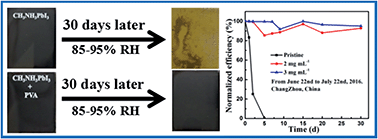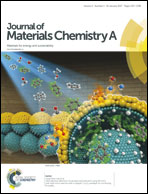Long-term stability of organic–inorganic hybrid perovskite solar cells with high efficiency under high humidity conditions†
Abstract
Balancing the high power conversion efficiency (PCE) and long-term stability of organic–inorganic hybrid perovskite solar cells (Pero-SCs) is a challenging factor for the commercialization of solar cells. Herein, a cost-effective and widely available water-soluble additive, polyvinyl alcohol (PVA), has been adopted to improve the film quality of CH3NH3PbI3 and enhance the efficiency and long-term tolerance to humidity. A PCE of 17.4% has been achieved for the device with PVA, showing an 11.6% increase compared to those of the devices without the additive. Most importantly, the unencapsulated devices retain over 90% of their initial efficiency even after 30 days in a high humidity environment (90% relative humidity), exhibiting greater humidity tolerance and superior stability. Our studies present a simple solution-based approach to fabricate high efficiency solar cells with long-term stability under high humidity conditions, potentially revealing new methods for the mass production of Pero-SCs.


 Please wait while we load your content...
Please wait while we load your content...